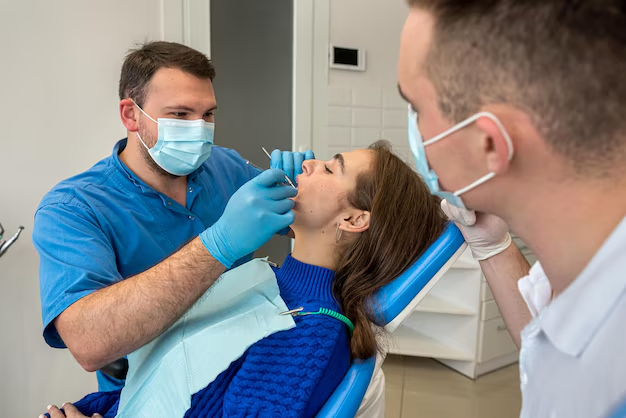Understanding Gum Cancer: Symptoms, Signs, and What to Look For
Spotting gum cancer early can be crucial in managing the disease effectively. But what does gum cancer look like? Knowing the signs and symptoms can empower individuals to seek timely medical attention and take control of their oral health. Let's explore the various aspects of gum cancer and its implications on oral health.
Recognizing the Symptoms: What Does Gum Cancer Look Like?
Gum cancer, or gingival cancer, often starts discreetly, making early detection challenging. Here are some signs to watch out for:
1. Unusual Growths or Lumps
Appearance of Lumps: One of the initial signs could be a lump or a thickening in the gums. These growths may vary in color from red, white, or even darker shades and may not be immediately painful.
2. Persistent Sores
Non-Healing Ulcers: Sores or ulcers in the mouth that persist for more than a few weeks can be a red flag. They may resemble canker sores but won't heal with time.
3. Bleeding and Swelling
Unexplained Bleeding: While occasional bleeding might not be alarming, persistent bleeding when brushing or eating should be monitored. Similarly, swollen gums without any apparent cause could be a concern.
4. Altered Gum Appearance
Changes in Color and Texture: Healthy gums should have a consistent pink hue and a firm texture. Any noticeable changes in these characteristics could warrant professional evaluation.
5. Pain and Discomfort
Persistent Pain: While pain isn't always present in early stages, any unexplained discomfort in the gums should prompt further investigation.
Diving Deeper: Causes and Risk Factors
Understanding what predisposes individuals to gum cancer is pivotal in prevention and early detection.
Tobacco and Alcohol Use
Major Risk Contributors: The use of tobacco in any form significantly increases the risk of oral cancers, including gum cancer. Excessive alcohol consumption also compounds this risk.
Poor Oral Hygiene
Gateway to Infections: Neglect in oral hygiene can lead to chronic infections or lesions, which might increase cancer risk. Regular brushing and flossing are essential preventive measures.
Human Papillomavirus (HPV)
Viral Influence: Certain strains of HPV have been linked to an increased risk of oral cancers. With HPV being sexually transmitted, it's another critical factor to consider.
Detection and Diagnosis: What to Expect at the Dentist's
Regular dental visits play a crucial role in early detection. Here's what a dental examination might involve:
Visual Examination
Checking for Anomalies: Your dentist will inspect your gums for any visible signs of abnormalities, such as unusual growths or discolorations.
Palpation
Feeling for Lumps: By gently feeling the gums and surrounding areas, the dentist can detect any lumps or unusual textures.
Biopsy Procedure
Definitive Diagnosis: If an abnormality is detected, a biopsy may be performed. This involves taking a small tissue sample for laboratory analysis to confirm the presence of cancerous cells.
Treatment Options: Navigating the Path Ahead
Early detection often leads to better outcomes, and understanding treatment options can empower individuals facing a diagnosis.
Surgical Intervention
Removing the Tumor: Surgery might be required to remove the cancerous growth. The extent of surgery depends on the stage and spread of the cancer.
Radiation and Chemotherapy
Targeted Treatments: These therapies aim to eliminate cancer cells that may remain post-surgery or to shrink tumors pre-operatively.
Rehabilitation and Follow-Up
Ensuring Complete Recovery: Post-treatment, regular follow-ups and rehabilitation may be necessary to monitor recovery and manage any side effects.
Prevention: Taking Charge of Your Oral Health
Preventive measures are key in minimizing the risk of gum cancer. Here are some actionable steps:
Maintain Good Oral Hygiene
Regular Brushing and Flossing: Keep plaque and gum diseases at bay with consistent oral care habits.
Limit Risk Behaviors
Avoiding Tobacco and Reducing Alcohol: Quitting smoking and limiting alcohol intake are immediate steps towards reducing cancer risk.
Regular Dental Check-Ups
Professional Evaluations: Schedule regular visits to your dentist for professional cleaning and routine examinations.
Wrap-Up
Understanding the visual and symptomatic indicators of gum cancer can make all the difference in early detection and treatment success. By staying vigilant about changes in the mouth and maintaining regular dental visits, individuals can take proactive steps in managing their oral health. Remember, any persistent changes in your oral health warrant medical attention, so never hesitate to consult a healthcare professional when in doubt.
Quick Reference Summary 📝
- 🔍 Recognize Symptoms: Watch for lumps, non-healing sores, persistent bleeding, color changes, and unexplained pain in the gums.
- ⚠️ Know Risk Factors: Be aware of tobacco and alcohol use, poor oral hygiene, and HPV as potential risk factors.
- 👨⚕️ Regular Dental Visits: Ensure regular check-ups for early detection and professional guidance.
- 🛡️ Prioritize Prevention: Maintain good oral hygiene, limit risk behaviors, and stay informed about oral health.
- 🗨️ Stay Proactive: Monitor any persistent changes and seek medical advice when necessary.

Related Articles
- Are Breast Cancer Lumps Painful
- Are Chills a Sign Of Cancer
- Are Colon Spasms a Sign Of Cancer
- Are Lytic Lesions Always Cancer
- Are Polyps Cancer
- Can a Blood Test Detect Cancer
- Can a Ct Scan Detect Cancer
- Can a Dexa Scan Show Cancer
- Can a Gastric Emptying Scan Show Cancer
- Can a Lung Biopsy Cause Cancer To Spread